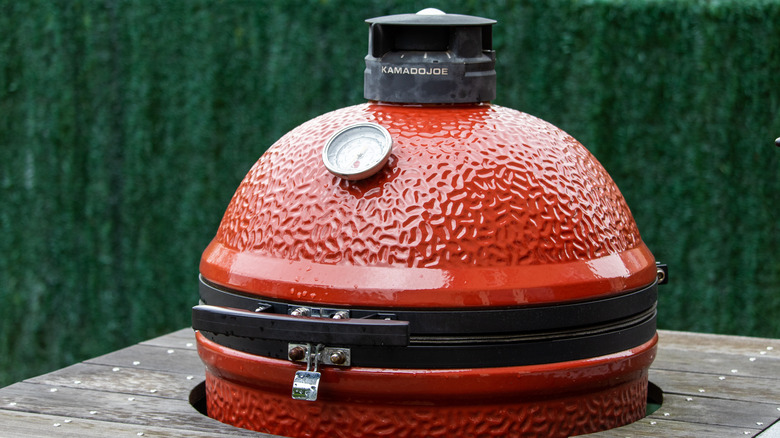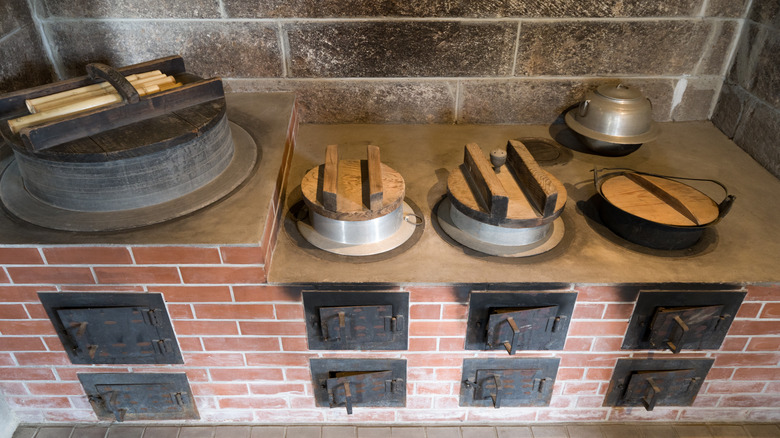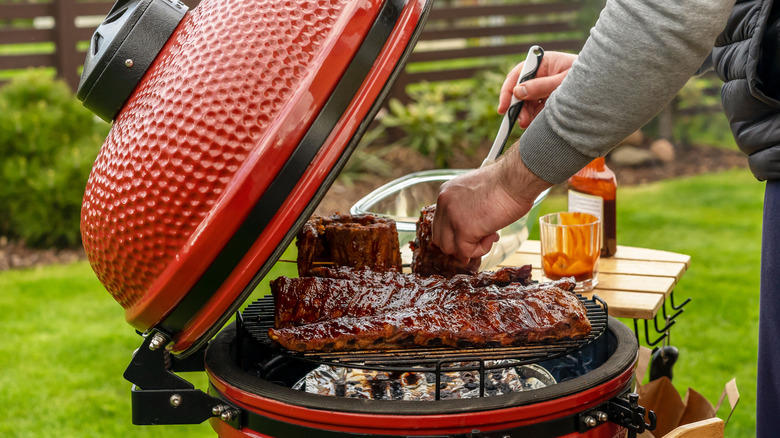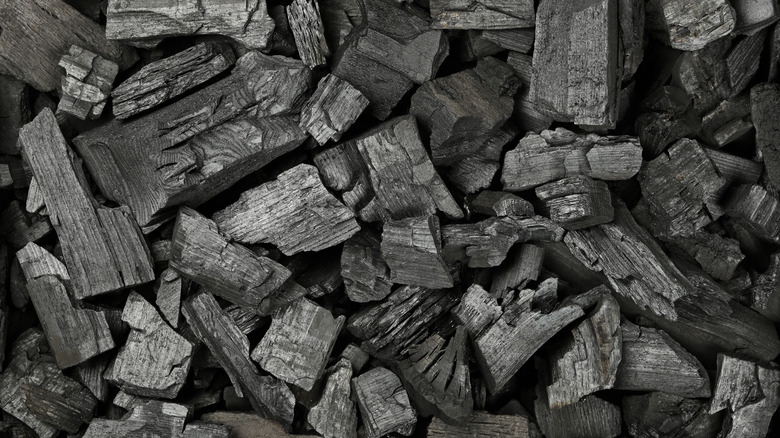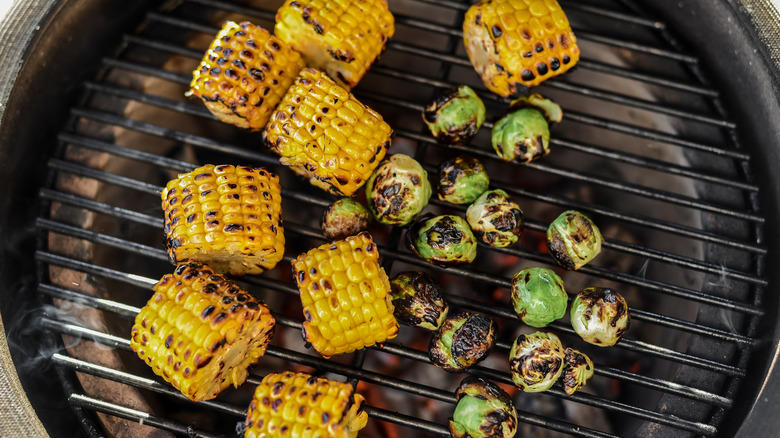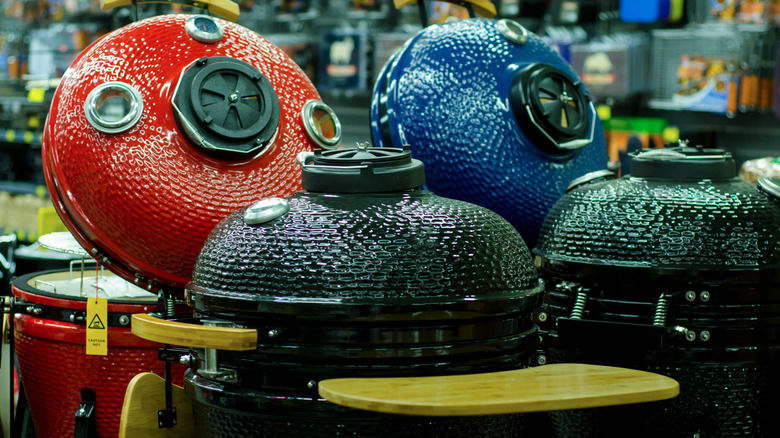The Untold Truth Of Kamado Grills
If you're ready to really take your barbecue game to the next level, for burgers, kabobs, pizza, and veggies, as well as succulent smoked meats, you should set your sights on a kamado grill. These cylindrical grills have a long history and for good reason. In addition to turning out delicious food, kamado grills are extremely efficient cookers and they're versatile, according to The Spruce Eats.
Often made of heavy-duty ceramic with a bright glaze, textured surface, a huge, domed lid, and an egg-meets-torpedo shape, a kamado grill quickly catches the eye in the backyard or on the deck. That shape and the ceramic body aren't just for looks: together they create an ideal environment for grilling and smoking that makes it easier to maintain temperatures, retain moisture, and deeply infuse food with smoke and flavor (via Family Handyman).
Food Fire Friends shares that not only are there a number of kamado grill manufacturers, the grills themselves are available in a range of colors and sizes. Some kamados are small enough to take along on camping trips and other behemoths can roast a whole pig. These grills are designed to last for years and years, and as such, Kamados can range in price from $750 to $1300 or higher. However, dedicated barbecue aficionados say that the quality of the food they produce means once you start grilling on a kamado you'll "never go back." There's a reason these grills have a legacy and have become so popular.
The ancient cooking method of a kamado
Kamado grills have a history going back more than 1,000 years. According to Kamado Jim, it's believed that the Chinese brought the idea of clay cooking vessels to Japan around 300 A.D. The Japanese gradually modified the design of the vessels over centuries of use and eventually created the first rice cooker called a mushikamado. A pot containing the rice sat inside the cooking vessel, and the temperature could be controlled to gently simmer the rice. (Barbecue Bible shares that mushikamados were used extensively in homes in Japan until electric rice cookers in the mid-20th century began to replace them.) As the design continued to evolve, cooking grates were eventually added to mushikamados, which allowed for meats and fish to be grilled or smoked in the cookers.
Kamado grills made their way abroad thanks to soldiers stationed in Japan just after World War II, who saw the ingenuity of the design and experienced the food prepared in them. They brought mushikamados back home with them, tinkering with the design and making changes — like adding vents to make it easier to manage the airflow. According to Kamado Jim, American Ed Fisher created the Big Green Egg in the 1970s, one of the most recognizable kamado grills that's still available today. His biggest improvement was to use a high-quality ceramic for grills that performed better and lasted longer.
Here's why kamado grills work so well
BBQ Guys share that kamado grills have several advantages over metal gas and charcoal grills. Because they're constructed of ceramic, kamado grills are much better insulated and they do a superior job of retaining heat. Once the grill reaches the desired temperature, you can easily keep it there to cook food more efficiently, and do it using less charcoal. They also share that kamados do a better job than metal grills of keeping moisture in foods, which is especially helpful for long, low-temperature cooking.
The versatility of kamados also makes them a worthwhile investment. With all the talk about smoking meats and "low and slow" cooking, you might think that it's the sole purpose of a kamado. However, Louisiana Grills points out that kamados are fantastic pizza ovens, moving the hot air through in a way that melts the cheese on top while also achieving that all-important crisp and chewy crust underneath. Kamado owners also use the grills to cook up whole chickens, steak, burgers, and even to bake bread. It's a smoker, grill, pizza oven, and bread oven all in one.
The Spruce Eats also notes that tiered racks are available for most models of kamado ovens. So although the primary cooking grate may be the size of that in a standard charcoal grill, the rack systems allow cooks to extend this space vertically. This means more burgers, more racks of ribs — more of everything.
Kamados use this kind of charcoal
Owning a kamado grill means that the old days of chemical-laden, charcoal briquettes — usually soaked with way too much lighter fluid by overeager grillers waiting with a lit match — are gone. And that's a good thing! Fine Cooking reports that charcoal briquettes, the little black cubes that are the stars of backyard barbecues, are made from the sawdust of various types of wood. Artificial binders are mixed in, and the mixture is compressed into individual briquettes. They take longer to light (hence all that lighter fluid), and they create a lot of ash. Fine Cooking also shares that foods cooked over briquettes can taste like chemicals and that briquettes also release more pollution into the air.
In contrast, natural lump charcoal is the recommended fuel for kamado grills. According to Serious Eats, lump charcoal is made of nothing but natural hardwoods, burned then bagged in their natural state. Lump charcoal lights more quickly than briquettes and burns hotter, and it's easier to control the heat of the charcoal using the air vents on the kamado. Fine Cooking also says that this hardwood lump charcoal gives a better-tasting and more pure smoke flavor to foods. And best of all, pieces of lump charcoal left after cooking can be cooled down and reused.
While Serious Eats points out that lump charcoal can cost more than bags of briquettes, the cleaner taste and ability to reuse the leftover charcoal can give grillers their money's worth.
How to cook on a kamado grill
The Spruce Eats notes that, although there is a learning curve to cooking on a kamado grill, namely in understanding how to reach the desired temperature, it's worth it in the end for the quality of grilled and smoked food you'll produce. To use a kamado grill, according to Food Fire Friends, you'll start by arranging a pile of lump charcoal in the bottom of the grill using a mixture of large and small pieces. The lid and vents should be open for maximum airflow. Light the charcoal with an electric starter, a chimney starter, or a firestarter.
After a short time, close the lid and monitor the temperature. The vents stay open so that oxygen feeds the fire and the coals can heat up. Once you're within about 50 degrees of your target temperature, you adjust the bottom and top vents to restrict air and slow down the heating to land at the temperature you want. A common mistake is to allow the grill temperature to race too high. With a little vigilance and some practice, you will get the hang of it!
And, remember to "burp" your grill. Big Green Egg describes this as lifting the grill lid an inch or two to let air in slowly. This prevents a ball of fire from rolling out, a type of backdraft that can happen with an oxygen-starved fire.
The many brands and sizes of kamado grills available today
According to Consumer Reports, the obsession with kamado grills really picked up after the debut of the Big Green Egg in the 1970s, and includes a devoted group of followers who call themselves "eggheads." Many other brands of kamados have emerged since then, including Weber, Primo, Kamado Joe, and Pit Boss. There's even a kamado grill made by Char-Broil, one of the most familiar brands of traditional, backyard charcoal grills. And despite the hallmark of kamado grills being the thick-walled, ceramic body, Grill Guide shares that there are metal kamado grills available now as well. These kamados have multiple layers of heavy-duty steel that insulate and retain heat as well as the ceramic grills.
In addition to all the brands of kamados, there are also a myriad number of sizes and shapes — a kamado grill for everybody! The largest grill from Kamado Joe has a 24-inch cooking area and three tiers of racks, while their smallest can be brought along to campsites and tailgating parties, per the brand. Big Green Egg also has a range of sizes, including one small model with its own built-in carrier. Primo Ceramic Grills touts the flexibility of their oval kamados that offer more direct and indirect heat grilling options (via Primo).
This could be the year you say goodbye to other grills and go kamado — and never look at grilling the same way again.
